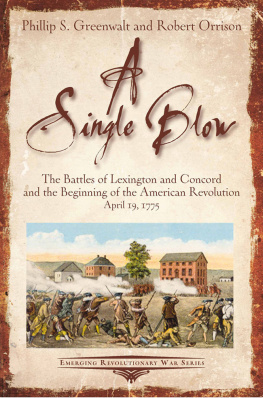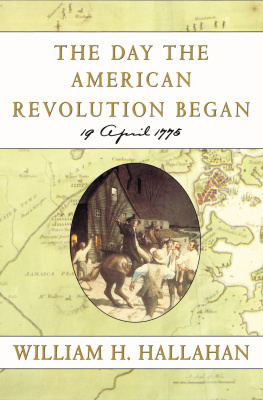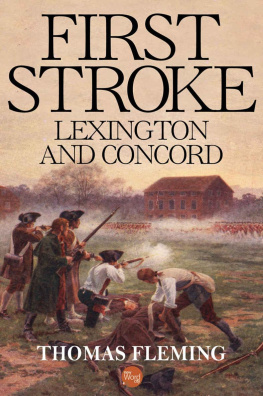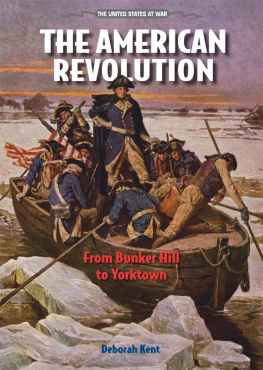Lexington
&
Concord
THE 19TH OF APRIL, 1775

Major John Pitcairn
Lexington
&
Concord
THE 19TH OF APRIL, 1775
HAROLD MURDOCK
DOVER PUBLICATIONS, INC.
Mineola, New York
Bibliographical Note
This Dover edition, first published in 2019, is an unabridged republication of The Nineteenth of April, 1775, of which 575 copies were originally printed by Houghton Mifflin Company, Boston, in 1923. The color frontispiece has been reproduced in black and white.
Library of Congress Cataloging-in-Publication Data
Names: Murdock, Harold, 18621934, author.
Title: Lexington and Concord : the 19th of April, 1775 / Harold Murdock.
Other titles: Nineteenth of April, 1775 | 19th of April, 1775
Description: Mineola, New York : Dover Publications, Inc., 2019. | This Dover edition, first published in 2019, is an unabridged republication of The Nineteenth of April, 1775, originally printed by Houghton Mifflin Company, Boston, in 1923.
Identifiers: LCCN 2019013634| ISBN 9780486838274 | ISBN 0486838277
Subjects: LCSH: Lexington, Battle of, Lexington, Mass., 1775. | Concord, Battle of, Concord, Mass., 1775.
Classification: LCC E241.L6 M7 2019 | DDC 973.3/311dc23
LC record available at https://lccn.loc.gov/2019013634
Manufactured in the United States by LSC Communications
83827701 2019
www.doverpublications.com
Preface
OF the three papers composing this volume the first and second were read before the Massachusetts Historical Society in 1916 and 1922, the third before the Colonial Society in 1921. By courtesy of these Societies they are now, with a few slight alterations, reprinted as read; and, as arranged, they form a consecutive commentary on the first battle of the American Revolution. I have approached the subject from a somewhat unusual point of view, which is sufficiently explained in the chapter on Historic Doubts. The military performances of our forefathers on the 19th of April have been voluminously presented, both in oratory and in print, and my interest was first drawn to the subject by a desire to learn what our adversaries did and thought on that fateful day. My study of the evidence on both sides has tempted me to test the reliability of commonly accepted versions of certain phases of the affair, colored, as they have been, by the local enthusiasms and jealousies which characterized the semi-centennial observances of 1825.
H. M.
March, 1923
Exhibiting a Fair and Impartial Account of the ENGAGEMENT fought on that day, chiefly in the Towns of CONCORD, LEXINGTON, and MENOTOMY, between a Detachment of His Brittanick Majestys Regular Troops and the Militia of the Province of MASSACHUSETTS BAY; with Candid Remarks upon certain Relations of that Sanguinary Event as set forth by other Hands.
Contents
Illustrations
photogravure frontispiece
From a colored photograph after a miniature owned by the Rev. E. A. Pitcairn-Campbell, of Vicar Cross, Chester, England, belonging to the Lexington Historical Society, reproduced through the courtesy of the Society.
(photogravure)
From an etching by Sidney L. Smith, published by Charles E. Goodspeed, after the original by A. Doolittle (1775).
(photogravure)
From the original executed in 1832 for John W. Barbers History of New Haven.
(photogravure)
From a lithograph after a drawing by M. Swett
(photogravure)
Photogravure plate, used in revised edition of Charles Hudsons History of Lexington (1913), kindly lent by the Lexington Historical Society.
(photogravure)
From the painting in the Lexington Town Hall owned by the Lexington Historical Society.
(photogravure)
From an etching by Sidney L. Smith, published by Charles E. Goodspeed, after the original by A. Doolittle (1775).
(photogravure)
From an etching by Sidney L. Smith published by Charles E. Goodspeed, after the original by A. Doolittle (1775).
(photogravure)
From an etching by Sidney L. Smith, published by Charles E. Goodspeed, after the original by A. Doolittle (1775).
(photogravure)
From the painting after Bettoni presented to the Town of Lexington by the Seventeenth Duke of Northumberland and now hanging in the Cary Memorial Library, Lexington. Reproduced by permission of the Selectmen. Photogravure plate kindly lent by the Colonial Society of Massachusetts.
From an exceedingly rare map published by J. DeCosta in London, July 29, 1775
Lexington
&
Concord
THE 19TH OF APRIL, 1775
I
HISTORIC DOUBTS ON THE BATTLE
AT LEXINGTON
I
HISTORIC DOUBTS ON THE BATTLE AT LEXINGTON
O N the 2d of September, 1824, Lafayette was a visitor in Concord, and the Honorable Samuel Hoar took occasion to remind him, in a public address, that he stood upon the spot where the first forcible resistance was made to the British arms. This simple assertion proved in a measure epoch-making. A half-century had passed since the great events to which Mr. Hoar referred, but his claim for Concord roused a storm of protest in Lexington. A bitter controversy ensued, and local pride and local historians were stirred to an extent that imperilled historic truth. The Town of Lexington took official cognizance of the Concord claim, and Elias Phinney, Esq., was charged with the task of demonstrating to all impartial minds that it was at Lexington, and not at Concord, that the embattled farmer fired that far-echoing shot that heralded American independence.
To assist Phinney in his work, depositions were extracted from ten aged citizens of Lexington, some of whom, fifty years before, had attended that early morning roll-call on the Common. Those venerable men, whose comrades in 1775 had been anxious to prove the peaceful intent and behavior of the minutemen, were now summoned to lend color to quite a contradictory theory. The Honorable Edward Everett, who delivered the oration at Concord on the fiftieth anniversary of the battle, was placed in a delicate position, and disclaimed any intention of pronouncing on questions in controversy. Phinneys pamphlet on the battle appeared in 1825. Concord had old men of her own, and they were summoned into the lists to support contentions put forth by the Reverend Ezra Ripley, who published his anti-Lexington tract in 1827.
The whole dispute seems strangely trivial to us now. It is hard to account for the time and ink that were wasted in the fruitless controversy; the recriminations and bitterness of spirit, which involved the clergy of neighboring towns; the wild straining at historical gnats and the wholesale swallowing of legendary camels, and all because of the phrasing of one sentence by the Honorable Samuel Hoar. Lexington had not always been as sensitive as she was in 1824.Parkers company did their full duty on the 19th of April, 1775, and that, in a crisis when courage and resolution were animating the hearts of thousands of Massachusetts men, they well deserve the title of the bravest of the brave.

Two results of this controversy are worth noting: the first, a development of local interest and enthusiasm in the subject, which remains unimpaired as bitterness has waned; the second, the accumulation of a mass of questionable evidence, which in exaggerated forms has gradually become accepted as history. It was certainly a keen revival of interest that started Phinney on his task; and every one of sufficient years in Lexington must have racked his brains for some memory of the great day. In 1863 the poet Longfellow became inspired with the subject, and in glorifying Paul Revere, innocently robbed William Dawes and Dr. Prescott of well-earned honors. Tradition, legend, tune, and song all played their part in the reconstruction of the Lexington story, until the schoolboy of my generation, however dull in history, knew for facts that Revere rode into Concord before dawn with news that the regulars were out, and that Major Pitcairn stirred his whiskey in the Concord Tavern, with blood-curdling threats that would have done credit to a pirate king.
Next page










